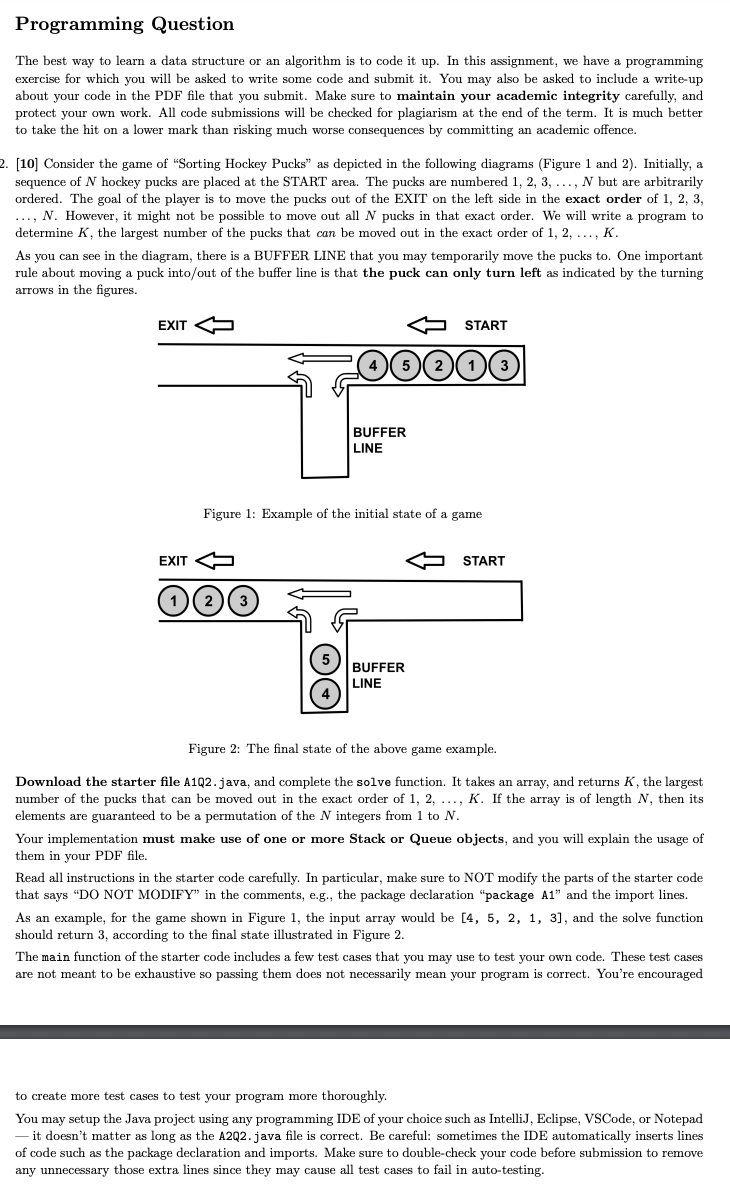Answered step by step
Verified Expert Solution
Question
1 Approved Answer
Please show all steps and answer question according to what is asked in question:Programming Question The best way to learn a data structure or an
Please show all steps and answer question according to what is asked in question:Programming Question
The best way to learn a data structure or an algorithm is to code it up In this assignment, we have a programming
exercise for which you will be asked to write some code and submit it You may also be asked to include a writeup
about your code in the PDF file that you submit. Make sure to maintain your academic integrity carefully, and
protect your own work. All code submissions will be checked for plagiarism at the end of the term. It is much better
to take the hit on a lower mark than risking much worse consequences by committing an academic offence.
Consider the game of "Sorting Hockey Pucks" as depicted in the following diagrams Figure and Initially, a
sequence of hockey pucks are placed at the START area. The pucks are numbered dots, but are arbitrarily
ordered. The goal of the player is to move the pucks out of the EXIT on the left side in the exact order of
However, it might not be possible to move out all pucks in that exact order. We will write a program to
determine the largest number of the pucks that can be moved out in the exact order of dots,
As you can see in the diagram, there is a BUFFER LINE that you may temporarily move the pucks to One important
rule about moving a puck intoout of the buffer line is that the puck can only turn left as indicated by the turning
arrows in the figures.
Figure : Example of the initial state of a game
Figure : The final state of the above game example.
Download the starter file AQ java, and complete the solve function. It takes an array, and returns the largest
number of the pucks that can be moved out in the exact order of dots, If the array is of length then its
elements are guaranteed to be a permutation of the integers from to
Your implementation must make use of one or more Stack or Queue objects, and you will explain the usage of
them in your PDF file.
Read all instructions in the starter code carefully. In particular, make sure to NOT modify the parts of the starter code
that says DO NOT MODIFY" in the comments, eg the package declaration "package A and the import lines.
As an example, for the game shown in Figure the input array would be and the solve function
should return according to the final state illustrated in Figure
The main function of the starter code includes a few test cases that you may use to test your own code. These test cases
are not meant to be exhaustive so passing them does not necessarily mean your program is correct. You're encouraged
to create more test cases to test your program more thoroughly.
You may setup the Java project using any programming IDE of your choice such as IntelliJ, Eclipse, VSCode, or Notepad
it doesn't matter as long as the java file is correct. Be careful: sometimes the IDE automatically inserts lines
of code such as the package declaration and imports. Make sure to doublecheck your code before submission to remove
any unnecessary those extra lines since they may cause all test cases to fail in autotesting. Here is the starter code. Only implement solve function: package A;
Do NOT modify the package declaration
import java.util.ArrayList;
Do NOT add any import
You may implement a new class here, such as a Stack or a Queue.
Any additional class that you use must be included in THIS file.
public class AQ
The function that you need to implement.
Read the assignment handout for the specification.
DO NOT MODIFY the declaration of the function its parameter types and return type
public static int solveint arr
TODO: implement this function
return ;
This main function contains a few test cases that can be used to check
that your code compiles and runs. Note that these test cases are NOT complete,
and you need to test your code thoroughly with more cases.
public static void mainString args
Printing "true" means the return value is correct.
int arr ;
System.out.println solvearr;
arr new int;
System.out.println solvearr;
arr new int;
System.out.println solvearr;
arr new int;
System.out.println solvearr;
arr new int;

Step by Step Solution
There are 3 Steps involved in it
Step: 1

Get Instant Access to Expert-Tailored Solutions
See step-by-step solutions with expert insights and AI powered tools for academic success
Step: 2

Step: 3

Ace Your Homework with AI
Get the answers you need in no time with our AI-driven, step-by-step assistance
Get Started


